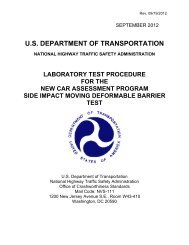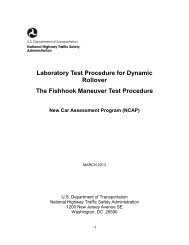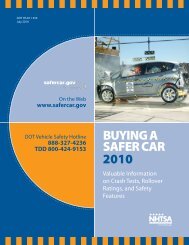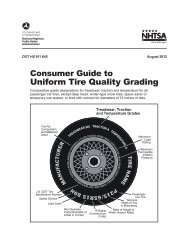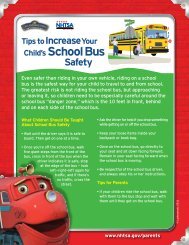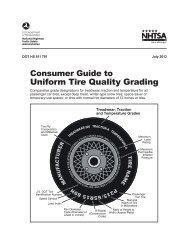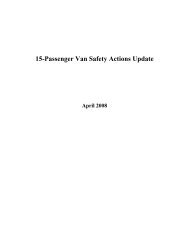Checklist and Tips for Safe Winter Driving - NHTSA
Checklist and Tips for Safe Winter Driving - NHTSA
Checklist and Tips for Safe Winter Driving - NHTSA
You also want an ePaper? Increase the reach of your titles
YUMPU automatically turns print PDFs into web optimized ePapers that Google loves.
CHECKLIST AND TIPS FOR<strong>Safe</strong> <strong>Winter</strong> <strong>Driving</strong>Get your car serviced now.No one wants to break down in any season, but especially not in cold or snowy winterweather. Start the season off right by ensuring your vehicle is in optimal condition.Visit your mechanic <strong>for</strong> a tune-up <strong>and</strong> other routine maintenance.»»Have your entire vehicle checked thoroughly <strong>for</strong> leaks, bad worn hoses, or otherneeded parts, repairs, <strong>and</strong> replacements.Check your battery.When the temperature drops, so does battery power. For gasoline-powered engines,be aware that it takes more battery power to start your vehicle in cold weather thanin warm. For electric <strong>and</strong> hybrid vehicles, the driving range is reduced <strong>and</strong> the batterysystems work better after they warm up. Make sure your battery is up to the challenges of winter by:»»Having your mechanic check your battery <strong>for</strong> sufficient voltage;»»Having the charging system <strong>and</strong> belts inspected;»»Replacing the battery or making system repairs, including simple things like tightening the batterycable connections;»»Making sure to keep fresh gasoline in an electric vehicle, to support the gasoline system.Check your cooling system.When coolant freezes it exp<strong>and</strong>s. This expansion can potentially damage your vehicle’s engine block.Don’t let this happen to your vehicle this winter. You should:»»Make sure you have enough coolant in your vehicle <strong>and</strong> that it’s designed to withst<strong>and</strong> the wintertemperatures you might experience in your area.»»See your vehicle owner’s manual <strong>for</strong> specific recommendations on coolant. A 50/50 mix of coolant towater is sufficient <strong>for</strong> most regions of the country.»»Thoroughly check the cooling system <strong>for</strong> leaks or have your mechanic do it <strong>for</strong> you.»»Check to see if your system has been flushed (draining the system <strong>and</strong> replacing the coolant). If ithasn’t been flushed <strong>for</strong> several years, have it done now. Over time, the rust inhibitors in antifreezebreak down <strong>and</strong> become ineffective. Coolant also needs to be refreshed periodically to remove dirt<strong>and</strong> rust particles that can clog the cooling system <strong>and</strong> cause it to fail.safercar.gov1
Fill your windshield washer reservoir.You can go through a lot of windshield wiper fluid fairly quickly in a single snowstorm,so be prepared <strong>for</strong> whatever Mother Nature might send your way.»»Completely fill your vehicle’s reservoir be<strong>for</strong>e the first snow hits.»»Use high-quality, “no-freeze” fluid.»»Buy extra to keep on h<strong>and</strong> in your vehicle.Check your windshield wipers <strong>and</strong> defrosters.<strong>Safe</strong> winter driving depends on achieving <strong>and</strong> maintaining the best visibility possible.»»Make sure your windshield wipers work <strong>and</strong> replace worn blades.»»Consider installing heavy-duty winter wipers if you live in an area that gets a lot ofsnow <strong>and</strong> ice.»»Check to see that your window defrosters (front <strong>and</strong> rear) work properly.Verify floor mat installation to prevent pedal interference.Incorrect or improperly installed floor mats in your vehicle may interfere with the operation of theaccelerator or brake pedal, increasing the risk of a crash. Remember these tips when installing newfloor mats to ensure safe operation of your vehicle:»»Remove old mats be<strong>for</strong>e the installation of new mats.»»Never stack mats, as that may increase the potential <strong>for</strong> pedal interference.»»Be sure to follow the manufacturer’s instructions <strong>for</strong> mat installation <strong>and</strong> use the available retentionclips to secure the mat in the proper position. This will prevent the mat from sliding <strong>for</strong>ward.»»Check that the mats are the correct size <strong>and</strong> fit <strong>for</strong> the vehicle <strong>and</strong> do not interfere with the fulloperation of the foot controls (accelerator, brake <strong>and</strong> clutch pedals). Whenever the interior of thevehicle is cleaned or the mats have been removed <strong>for</strong> any reason, verify that the driver mat has beenreinstalled correctly.Inspect your tires.If you plan to use snow tires, have them installed be<strong>for</strong>e the snow storms hit.Check out www.safercar.gov <strong>for</strong> tire ratings be<strong>for</strong>e buying new ones. For existingtires, check to ensure they are properly inflated (as recommended by your vehiclemanufacturer), the tread is sufficient with no uneven wear, <strong>and</strong> that the rubber is ingood overall condition. Note that tire rubber starts to degrade after several years,<strong>and</strong> older tires need to be replaced even if they have not seen much wear.Regardless of season, you should inspect your tires at least once a month <strong>and</strong>always be<strong>for</strong>e setting out on a long road trip. It only takes about five minutes. If youfind yourself driving under less-than-optimal road conditions this winter, you’ll beglad you took the time.»»Check tire pressure <strong>and</strong> make sure each tire is filled to the vehicle manufacturer’s recommendedinflation pressure, which is listed in your owner’s manual <strong>and</strong> on a placard located on the driver’sside doorjamb (called the “B-pillar”). If a vehicle does not have a B-pillar, then the placard is placedsafercar.gov2
Plan your travel <strong>and</strong> route.Keep yourself <strong>and</strong> others safe by planning ahead be<strong>for</strong>e you venture out into badweather.»»Check the weather, road conditions, <strong>and</strong> traffic; plan to leave early if necessary.»»Don’t rush! Allow plenty of time to get to your destination safely.»»Familiarize yourself with directions <strong>and</strong> maps be<strong>for</strong>e you go, even if you use a GPSsystem, <strong>and</strong> let others know your route <strong>and</strong> anticipated arrival time.»»Keep your gas tank close to full, even with an electric vehicle. If you get stuck in atraffic jam or in snow, you might need more fuel to get home or keep warm. Note:To avoid carbon monoxide poisoning when stuck in snow, be sure to keep yourvehicle’s exhaust pipe clear of snow <strong>and</strong> ice, run your vehicle only in the open with the windowspartially down, <strong>and</strong> run it only long enough to keep warm.»»Wait until road <strong>and</strong> weather conditions improve be<strong>for</strong>e venturing out in your vehicle. If roadconditions are hazardous, avoid driving if possible.Stock your vehicle.Carry items in your vehicle to h<strong>and</strong>le common winter driving tasks, such as cleaning off yourwindshield, as well as any supplies you might need in an emergency. Keep the following on h<strong>and</strong>:»»Snow shovel, broom, <strong>and</strong> ice scraper;»»Abrasive material such as s<strong>and</strong> or kitty litter, in case your vehicle gets stuck in the snow;»»Jumper cables, flashlight, <strong>and</strong> warning devices such as flares <strong>and</strong> markers;»»Blankets <strong>for</strong> protection from the cold;»»And a cell phone with charger, water, food, <strong>and</strong> any necessary medicine (<strong>for</strong> longer trips or whendriving in lightly populated areas).Learn what to do in a winter emergency.If you are stopped or stalled in wintry weather, follow these safety rules:»»Stay with your car <strong>and</strong> don’t overexert yourself»»Put bright markers on the antenna or windows <strong>and</strong> keep the interior domelight turned on;»»To avoid asphyxiation from carbon monoxide poisoning, don’t run your car<strong>for</strong> long periods of time with the windows up or in an enclosed space. If you must run your vehicle,clear the exhaust pipe of any snow <strong>and</strong> run it only sporadically — just long enough to stay warm.Protect yourself <strong>and</strong> your loved ones.»»Remember to always wear your seat belt. Ensure that everyone in your vehicle is buckled up as well.»»Do not text or engage in any other activities that may distract you while driving.»»While thick outerwear will keep your children warm, it can also interfere with the proper harness fitof your child in their car seat. Place blankets around your child after the harness is snug <strong>and</strong> secure.»»Never leave your child unattended in or around your vehicle.safercar.gov49254-121012-v3



